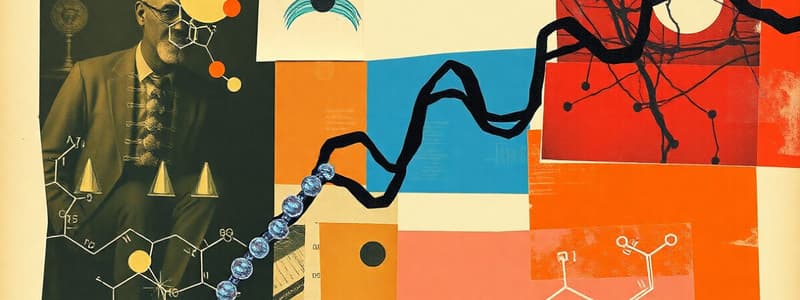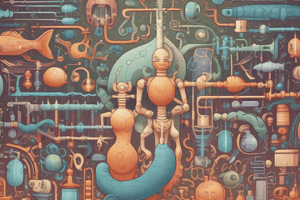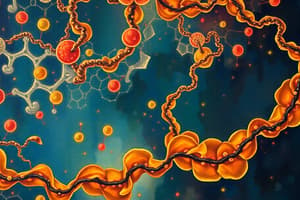Podcast
Questions and Answers
Which component acts as a nitrogen donor for most amino acids in higher organisms?
Which component acts as a nitrogen donor for most amino acids in higher organisms?
- Glycolysis intermediates
- Ubiquitin
- Glutamate (correct)
- Ammonia
What is the primary role of ATP in the biosynthesis of amino acids?
What is the primary role of ATP in the biosynthesis of amino acids?
- To provide energy for protein degradation
- To transfer amino groups during transamination
- To facilitate the pentose phosphate pathway
- To reduce atmospheric nitrogen to ammonia (correct)
How are proteins marked for degradation within the cell?
How are proteins marked for degradation within the cell?
- By ubiquitination (correct)
- By acetylation
- By phosphorylation
- By glycosylation
Which of the following pathways does NOT provide carbon skeletons for amino acid synthesis?
Which of the following pathways does NOT provide carbon skeletons for amino acid synthesis?
What is the overall process called that converts atmospheric nitrogen into ammonia?
What is the overall process called that converts atmospheric nitrogen into ammonia?
Which amino acid is synthesized from phenylalanine?
Which amino acid is synthesized from phenylalanine?
Which group of amino acids can humans synthesize if dietary sources are insufficient?
Which group of amino acids can humans synthesize if dietary sources are insufficient?
What type of reaction is primarily involved in the biosynthesis of aspartate and alanine from their corresponding α-keto acids?
What type of reaction is primarily involved in the biosynthesis of aspartate and alanine from their corresponding α-keto acids?
Which essential amino acid is crucial for synthesizing the neurotransmitter serotonin?
Which essential amino acid is crucial for synthesizing the neurotransmitter serotonin?
What characterizes essential amino acids compared to nonessential amino acids?
What characterizes essential amino acids compared to nonessential amino acids?
Which amino acid is formed from α-ketoglutarate through reductive amination?
Which amino acid is formed from α-ketoglutarate through reductive amination?
Which of the following is NOT classified as a nonessential amino acid?
Which of the following is NOT classified as a nonessential amino acid?
What is the main role of aminotransferases (transaminases) in amino acid metabolism?
What is the main role of aminotransferases (transaminases) in amino acid metabolism?
Which of the following statements accurately describes essential amino acids?
Which of the following statements accurately describes essential amino acids?
What is the primary role of ubiquitin in protein turnover?
What is the primary role of ubiquitin in protein turnover?
Which enzyme is responsible for transferring ubiquitin to the target protein?
Which enzyme is responsible for transferring ubiquitin to the target protein?
What happens when there is a defect in the E3 enzyme related to protein turnover?
What happens when there is a defect in the E3 enzyme related to protein turnover?
How long is the half-life of the protein insulin typically?
How long is the half-life of the protein insulin typically?
What is the significance of a chain of 4 or more ubiquitin molecules?
What is the significance of a chain of 4 or more ubiquitin molecules?
Which of the following conditions is associated with a defect in a member of the E3 family?
Which of the following conditions is associated with a defect in a member of the E3 family?
What is the primary source of amino acids for humans?
What is the primary source of amino acids for humans?
Which amino acid serves as the 'gateway' between amino groups of most amino acids and free ammonia?
Which amino acid serves as the 'gateway' between amino groups of most amino acids and free ammonia?
What percentage of the earth's newly fixed nitrogen is contributed by diazatrophic microorganisms?
What percentage of the earth's newly fixed nitrogen is contributed by diazatrophic microorganisms?
What is the primary clinical significance of measuring serum AST and ALT levels?
What is the primary clinical significance of measuring serum AST and ALT levels?
What role does the reductase play in the nitrogenase complex?
What role does the reductase play in the nitrogenase complex?
What enzyme interconverts pyruvate and glutamate?
What enzyme interconverts pyruvate and glutamate?
What is the effect of hepatic cell injury on serum aminotransferase activity?
What is the effect of hepatic cell injury on serum aminotransferase activity?
What is the primary role of amino acids in the body?
What is the primary role of amino acids in the body?
What is the primary function of leghemoglobin in root nodules of leguminous plants?
What is the primary function of leghemoglobin in root nodules of leguminous plants?
How is NH4+ incorporated into amino acids?
How is NH4+ incorporated into amino acids?
Which cofactor is essential for the activity of aminotransferases?
Which cofactor is essential for the activity of aminotransferases?
Which process reduces atmospheric nitrogen (N2) to ammonia (NH3)?
Which process reduces atmospheric nitrogen (N2) to ammonia (NH3)?
What happens to excess amino acids after immediate metabolic needs are satisfied?
What happens to excess amino acids after immediate metabolic needs are satisfied?
How many ATP molecules are hydrolyzed to produce two molecules of NH3?
How many ATP molecules are hydrolyzed to produce two molecules of NH3?
What metabolic role do excess amino acids serve?
What metabolic role do excess amino acids serve?
What effect does extreme malnutrition, specifically Kwashiokor, have on serum proteins?
What effect does extreme malnutrition, specifically Kwashiokor, have on serum proteins?
What is the effect of oxygen on the nitrogenase complex?
What is the effect of oxygen on the nitrogenase complex?
Which compound is involved in the reversible reaction catalyzed by aspartate aminotransferase?
Which compound is involved in the reversible reaction catalyzed by aspartate aminotransferase?
Which of the following factors can lead to liver damage that is detectable through AST and ALT levels?
Which of the following factors can lead to liver damage that is detectable through AST and ALT levels?
Which amino acids act as nitrogen donors for most amino acids?
Which amino acids act as nitrogen donors for most amino acids?
Which of the following is NOT a source of carbon backbones for amino acid biosynthesis?
Which of the following is NOT a source of carbon backbones for amino acid biosynthesis?
From where do most amino acids obtain their nitrogen, apart from glutamate and glutamine?
From where do most amino acids obtain their nitrogen, apart from glutamate and glutamine?
What are the primary types of bacteria involved in nitrogen fixation?
What are the primary types of bacteria involved in nitrogen fixation?
What happens if one essential amino acid is deficient in the body?
What happens if one essential amino acid is deficient in the body?
What does the process of protein turnover involve?
What does the process of protein turnover involve?
Flashcards
Protein Synthesis
Protein Synthesis
The process of building proteins from individual amino acids.
Nitrogen Fixation
Nitrogen Fixation
A process where certain microorganisms convert nitrogen gas from the atmosphere into ammonia, which is usable by other organisms.
Carbon Skeletons
Carbon Skeletons
The primary source of carbon atoms for the synthesis of various amino acids.
Glutamate
Glutamate
Signup and view all the flashcards
Ubiquitin
Ubiquitin
Signup and view all the flashcards
Protein turnover
Protein turnover
Signup and view all the flashcards
Amino acids
Amino acids
Signup and view all the flashcards
Amino acid oxidation
Amino acid oxidation
Signup and view all the flashcards
Kwashiokor
Kwashiokor
Signup and view all the flashcards
Ammonia (NH3)
Ammonia (NH3)
Signup and view all the flashcards
Glycolytic pathway, pentose phosphate pathway, citric acid cycle
Glycolytic pathway, pentose phosphate pathway, citric acid cycle
Signup and view all the flashcards
Nitrogen excretion
Nitrogen excretion
Signup and view all the flashcards
Amino Acid Biosynthesis: Families
Amino Acid Biosynthesis: Families
Signup and view all the flashcards
Essential Amino Acids
Essential Amino Acids
Signup and view all the flashcards
Nonessential Amino Acids
Nonessential Amino Acids
Signup and view all the flashcards
Steps and Essential Amino Acids
Steps and Essential Amino Acids
Signup and view all the flashcards
Aspartate, Alanine, and Glutamate Synthesis
Aspartate, Alanine, and Glutamate Synthesis
Signup and view all the flashcards
Glutamate Synthesis
Glutamate Synthesis
Signup and view all the flashcards
Aspartate and Alanine Synthesis
Aspartate and Alanine Synthesis
Signup and view all the flashcards
Aminotransferases
Aminotransferases
Signup and view all the flashcards
Aspartate aminotransferase (AST)
Aspartate aminotransferase (AST)
Signup and view all the flashcards
Alanine aminotransferase (ALT)
Alanine aminotransferase (ALT)
Signup and view all the flashcards
Glutamate's role in aminotransferase reactions
Glutamate's role in aminotransferase reactions
Signup and view all the flashcards
Clinical significance of AST and ALT
Clinical significance of AST and ALT
Signup and view all the flashcards
Protein degradation
Protein degradation
Signup and view all the flashcards
Amino acid catabolism
Amino acid catabolism
Signup and view all the flashcards
Ubiquitin-activating enzyme (E1)
Ubiquitin-activating enzyme (E1)
Signup and view all the flashcards
Ubiquitin-conjugating enzyme (E2)
Ubiquitin-conjugating enzyme (E2)
Signup and view all the flashcards
Ubiquitin–protein ligase (E3)
Ubiquitin–protein ligase (E3)
Signup and view all the flashcards
Angelman syndrome
Angelman syndrome
Signup and view all the flashcards
Polyubiquitination
Polyubiquitination
Signup and view all the flashcards
What enzyme performs nitrogen fixation?
What enzyme performs nitrogen fixation?
Signup and view all the flashcards
How much energy does nitrogen fixation need?
How much energy does nitrogen fixation need?
Signup and view all the flashcards
Who are the main nitrogen fixers?
Who are the main nitrogen fixers?
Signup and view all the flashcards
What kind of plants use nitrogen fixation?
What kind of plants use nitrogen fixation?
Signup and view all the flashcards
How do legumes protect nitrogenase?
How do legumes protect nitrogenase?
Signup and view all the flashcards
What is the role of glutamate and glutamine in nitrogen assimilation?
What is the role of glutamate and glutamine in nitrogen assimilation?
Signup and view all the flashcards
How does glutamine synthase work?
How does glutamine synthase work?
Signup and view all the flashcards
Study Notes
Amino Acid Metabolism 1
- Proteins from diet and cellular breakdown provide a steady supply of amino acids
- Amino acids are used to build proteins and other nitrogenous compounds like nucleotides, heme, and neurotransmitters
- Excess amino acids are not stored but used as metabolic fuel (oxidized or converted to glycogen or fat)
- A study of amino acid metabolism connects basic biochemistry with clinical medicine, especially deficits in amino acids impact functional proteins like muscles and hemoglobin
- Malnutrition (Kwashiorkor) results in muscle wasting, apathy, inadequate growth, brain effects and lowered serum proteins (e.g., albumin) leading to tissue edema (swelling)
Learning Objectives
- How nitrogen is incorporated into amino acids/proteins
- How nitrogen is transported throughout the body
- What controls protein turnover
- How the body removes excess nitrogen
- Identifying metabolic errors in amino acid metabolism
Amino Acid Biosynthesis
- Ammonia is the source of nitrogen
- Carbon backbones come from glycolytic pathway, pentose phosphate pathway, or the citric acid cycle
Nitrogen Fixation
- Nitrogen (N2) is an inert gas in the atmosphere
- Soil and symbiotic bacteria fix nitrogen (reducing N2 to NH3 (ammonia))
- Nitrogenase complex of reductase and iron-molybdenum nitrogenase helps, reacting optimally at 10°C and 1 atm
- 16 ATP molecules are hydrolyzed for each two NH3 molecules
- Diazotrophic microorganisms are responsible for fixing 60% of the Earth's nitrogen annually (approx. 10^11 kg)
- Ammonia can also be obtained from nitrate (NO3-) reduction
Maintaining Low Oxygen in Root Nodules
- Oxidative phosphorylation (ATP supply for nitrogen fixation) requires oxygen
- Nitrogenase is inactivated by oxygen
- Leguminous plants maintain low oxygen in root nodules using leghemoglobin (hemoglobin homolog)
Ammonium Ion Assimilation
- NH3 generated by nitrogenase becomes NH4+
- Glutamate and glutamine act as nitrogen donors to other amino acids
- Glutamate contributes the α-amino group to most amino acid synthesis
- Glutamine adds its side-chain nitrogen for synthesis of tryptophan and histidine
Amino Acids from Intermediates
- Majority of amino acids other than glutamate and glutamine derive nitrogen from glutamate or glutamine
- Carbon skeletons used for amino acid synthesis are produced from glycolysis, the citric acid cycle, or the pentose phosphate pathway
Amino Acid Families
- Amino acids are categorized based on biosynthetic pathways
- Essential amino acids cannot be synthesized by the human body
- Non-essential amino acids can be synthesized
Essential vs Non-Essential Amino Acids
- Humans synthesize some amino acids
- 9 amino acids (essential) are obtained from the diet
- 11 amino acids (non-essential) can be synthesized if required
Protein Turnover
- Cellular proteins are continuously degraded and resynthesized
- Essential for removing damaged and short-lived proteins
- Half-lives vary widely across proteins (e.g., insulin ~1 hour, hemoglobin ~115 days)
Ubiquitin's Role in Protein Turnover
- Ubiquitin (a small protein) tags proteins for destruction
- Ubiquitin is present in all eukaryotic cells
- Ubiquitin attaches to lysine residues on target proteins, needing ATP
Enzymes Involved in Protein Ubiquitination
- E1 (activating enzyme) adenylates ubiquitin
- E2 (conjugating enzyme) transfers ubiquitin to E2
- E3 (ligase) attaches ubiquitin to the target protein
Importance of E3 Proteins
- Defective E3 proteins lead to protein accumulation, causing diseases (e.g., Angelman syndrome).
- E3 overexpression is linked to autism.
- Inappropriate protein turnover can contribute to cancer
Studying That Suits You
Use AI to generate personalized quizzes and flashcards to suit your learning preferences.




